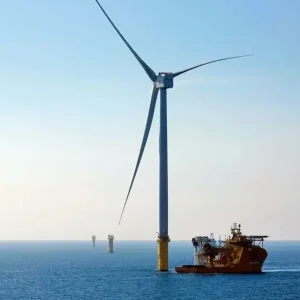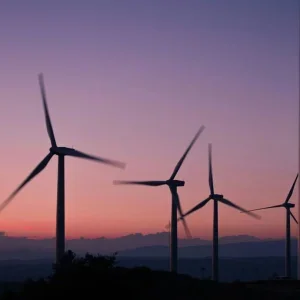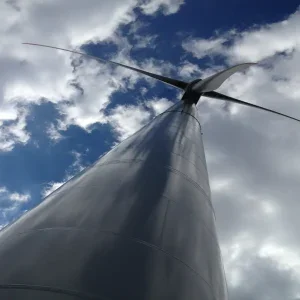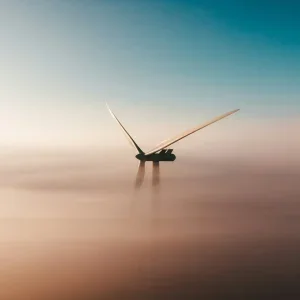Regular inspection is the only way to ensure turbine blades, towers and other components continue to perform optimally and safely. Blade deterioration can cause reduced energy production in its early stages, and, eventually, catastrophic and costly collapse if left uncorrected. But with 314,000 installed wind turbines globally by the end of 2015 and numbers still growing fast, manually inspecting each turbine annually is becoming increasingly impractical.
Traditionally, blade and tower inspection took place from the ground with simple visual examinations using binoculars, telescopes or telephoto cameras. As machines grow larger, this is becoming less and less effective, with closer inspection needed to spot defects.
However, inspecting blade surfaces manually using abseil, crane or cable-suspended platform access is slow, expensive and, taking into account the considerable height involved, potentially dangerous. Remotely operated aerial vehicles (ROAVs), also known as unmanned aerial vehicles (UAVs) or, more commonly, drones, offer a faster, cheaper and more flexible alternative.
Eye in the sky
Flying a commercial-grade drone fitted with a high-resolution video camera close to turbine components commands a view almost as good as that available to people dangling at the end of a rope. Reducing the time spent working at great heights means far greater safety, plus minimal downtime for what is an extremely expensive asset.
Drones are already used to inspect many other high, hard-to-access installations, from petrochemical refinery chimneys and transmission line pylons to the interior of power station coal-fired boilers. Shell and Maersk Drilling were among the early adopters.
“Drones are quick, easy and present much less of a safety hazard,” says Andy Newman, project manager at RES consultancy. “Rather than completely replacing rope access, they are currently used to make the first pass inspection, with any areas of interest then inspected manually.”
Research by Navigant released in late 2015 values the global market for inspecting wind turbines using drones at $6 billion a year by 2024.
That includes drone hardware, but the services business alone is expected to near $1 billion in cumulative global revenue by 2020.
This ballooning demand for drone inspection has prompted an explosion of service providers across Europe, North America and Asia. Deutsche Windtechnic, Atmoscam, Windspect and Ventus to name a few: there is a long list of established drone inspection suppliers that are now moving into turbine surveys.
UK drone operator Strat Aero is one example, recently winning a wind turbine inspection contract with Kansas electricity provider Westar Energy. This initial proof-of-concept contract will see the company inspect 53 turbines in two of five farms operated by Westar at a rate of six turbines a day.
Strat Aero hopes to survey the remaining 259 turbines across Westar’s five fields, as well as others operated by the US utility. CEO of Strat Aero
Tony Dunleavy says, “This agreement follows an extended trialling process and signals a breakthrough for Strat Aero into a significant and potentially lucrative market.”
Right tools for the job
Founded by an ex-rope-access technician, Scottish outfit Cyberhawk built its drone expertise in oil and gas and has also worked extensively in other industries. For some years now, it has used drones to survey prospective onshore wind site locations.
In this application, drones can cover more than 100ha in a single day and reach areas that no human surveyor ever could. Compared with lidar surveys carried out by small conventional aircraft, the low-altitude drones offer increased resolution and less interference from atmospheric conditions. In the past couple of years, inspecting turbine blades has become a significant part of Cyberhawk’s business.
“Compared with rope access and elevated platforms, there is no working at height and we are typically two to four times faster,” says Philip Buchan, Cyberhawk’s commercial director. “On average, we can inspect four turbines a day, whereas rope access will only manage one.”
Cyberhawk employs two-man teams, one as the pilot and the other to control the camera. The company founded its own specialist training centre to educate its staff and uses state-of-the-art hardware, such as cameras that can measure defects to a tolerance of 5mm.
“Most drone cameras are designed to take pictures at long range rather than a high-quality close-up,” says Buchan. “You need the right equipment, procedures and training to get a reliable, high-definition image.”
In 2015, Cyberhawk conducted an annual inspection campaign on more than 100 wind turbines operated by a large utility. That included close visual inspection of each blade’s leading edge, trailing edge, pressure and suction sides. On at least two occasions, turbines were not restarted following the inspection after it revealed a safety-critical defect.
Cyberhawk moved into offshore wind turbine inspection in 2015. A drone’s ability to examine turbine blades, nacelles, towers and transition pieces in a single deployment is even more attractive when accessing the turbine requires a two-hour boat trip. Cyberhawk has also used its drones to examine other offshore structures like met masts and transformer stations.
“We have worked at most of the operational offshore wind farms in the UK,” says Buchan. “We can work at up to a 30kt wind speed, but very heavy rain is a limitation. In 2015, we conducted 500 blade inspections. In 2016, we carried out well over 1,000.”
Today’s multi-rotor drones are well up to coping with offshore conditions, with robust stability in strong winds and a host of automatic controls that let them fly a pre-set survey route. Newman highlights the latest drones’ ability to video splash zones at an offshore structure’s waterline using auto hover control. This is a difficult and potentially dangerous area to check manually.
“Currently, there is close visual inspection from a small daughter craft,” he notes. “Drones using terrain-following control can rise quickly out of the way of waves and so inspect the splash zone at close range.”
Time to recharge
The only fly in the ointment is the limited flying time that even the best drones offer. At the moment, they can carry up to 3kg in winds as high as 30kt, but only for around 15 minutes. Landing to change battery packs is the usual solution, but new fuel-cell technology could be a better answer.
Intelligent Energy is currently testing a lightweight hydrogen fuel cell that can keep a small drone airborne for two hours or more. However, the prototype power pack weighs around 1.5kg, heavier than a standard battery. And although the hydrogen can be recharged quickly, there is the question of how to transport and store this highly explosive gas.
An intriguing alternative from Invisotech is to dispense with rotors altogether and instead use powerful electromagnets to cling to and climb steel towers. Its tracked remotely operated vehicle (ROV) mounts an AC field measurement probe and a high-resolution camera to check tower welds for cracks, with a Wi-Fi link to an onsite van used for control and data transfer. From its position on the tower, the ROV’s high-resolution camera can also inspect blades at close range.
“Inspection via rope access is tricky, slow and potentially hazardous,” says Dr Alan Lowdon, chief executive at Invisotech. “Our ROV has a longer battery life and is more stable than a drone, which makes for a better-quality image. We video the moving blades and then home in on any degradation.”
Reduced maintenance costs and increased safety are again the benefits, with the unique option of inspecting while the turbine is still operating. “We keep the asset working while you conduct NDT inspection of the tower welds,” says Lowdon.
Invisotech successfully trialled its ROV at ORE Catapult’s training facility in 2014 and is now marketing it commercially, demonstrating the technology to the likes of Jacobs, ENGIE and E.ON.
“The system is working fantastically well but we need to gain the confidence of the utilities to gain adoption,” says Lowdon. “Tower structural integrity isn’t really yet on the radar of most companies despite some well-documented global incidents of tower failure.”
The company is currently working on a version of the technology to use offshore that will become the focus once the onshore service is well established. “We could also work subsea if we choose to develop in that direction,” says Lowdon.
Big data
As well as thorough training for operators and analysts, the final element of the inspection solution lies in data analysis systems that help automate image processing and analysis. With wind turbine owners and operators already deluged by data from condition-based monitoring systems, these tools mitigate the ‘photo fatigue’ associated with capturing, analysing and cataloguing the vast amount of blade-surface image data collected across the wind turbine fleet.
Cyberhawk employs its iHawk asset management software to store, organise and analyse the high-definition images it acquires, logging the specific location and size of each defect and providing an engineering commentary. Via the application, the client can then quickly assess any damage, and then prioritise repairs and allocate budget for the maintenance required.
This will be even more important in the future. Navigant predicts that drone hardware and services will become largely commoditised and that “the inspection companies that provide the best blade condition analysis service will be the market leaders”.
Offshore or onshore, wind turbine operators contend with a challenging, even hostile, inspection environment that requires considerable time, effort and budget to manage safely. Drone inspection holds out the promise of greater efficiency, reduced risk to personnel and lower costs. With further development, these ingenious machines will have even more potential at the wind industry’s disposal.






